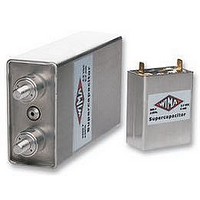SCSRA1B400RC00MV00 WIMA, SCSRA1B400RC00MV00 Datasheet - Page 3

SCSRA1B400RC00MV00
Manufacturer Part Number
SCSRA1B400RC00MV00
Description
Supercapacitors 2.5V 400F 20% TOL RECTANGULAR
Manufacturer
WIMA
Datasheet
1.SCSRA1B300RC00MV00.pdf
(5 pages)
Specifications of SCSRA1B400RC00MV00
Capacitance
400 Farads
Tolerance
20 %
Voltage Rating
2.5 Volts
Product
Super Capacitors
Capacitance Tolerance
± 20%
Capacitor Mounting
Chassis
Lead Spacing
36mm
Operating Temperature Range
-30°C To +65°C
External Depth
26.5mm
Rohs Compliant
Yes
Svhc
No SVHC (20-Jun-2011)
Lead Free Status / Rohs Status
Lead free / RoHS Compliant
Other names
R-400/2.5/20 SUPERCAP
110
Technical Data and Applications of
WIMA Double-Layer Capacitors
The construction principle of a Double-
Layer Capacitor can be described as a
plate capacitor where the most important
aim is to obtain electrodes with an extre-
mely large surface. For this purpose activa-
ted carbon is ideally suited, as it allows to
achieve capacitance values of up to 100 F/
g of active mass of the electrode. The elec-
trolyte, the conductive liquid between the
electrodes is a conducting salt dissolved in
an aqueous or organic solvent which per-
mits to apply voltages of 2.5 V.
Construction principle of the WIMA
Double-Layer Capacitor
The actual double-layer consists of ions
which, when voltage is applied, attach
to the positive or negative electrode cor-
responding to their opposite poles and
thus create a dielectric gauge of a few
Angstrom only. This results in a very high
capacitance yield caused by the very huge
surface of the electrode in accordance
with the formula
To visualise this, the internal surface of a
Double-Layer Capacitor would cover seve-
ral football pitches.
A permeable diaphragm acting as a
separating layer and called separator
avoids short-circuit between the two elec-
trodes and considerably influences the
characteristics of the capacitor. Charge or
discharge of the Double-Layer Capacitor
is combined with the transformation of the
layers in the electrical field and thus with
the movement of the charge carriers in the
solvent - even through the separator film.
Construction Principle
C =
e
x
Distance
Surface
This phenomenon represents the main rea-
son for the modest AC voltage capability
and the steep decrease of capacitance
versus frequency exhibited by Double-
Layer Capacitors.
Several SuperCap cells can be built up
to enormous capacitances of the desired
voltage by means of series or parallel
connection (cascade). When cascading
SuperCaps, the voltage of single cells
must not exceed 2.5 V (decomposition of
the electrolyte!) Hence, series connections
need in any case to be balanced since a
possibly slightly different aging of the indi-
vidual cells due to temperature may over
time cause deviating capacitances and
thus different voltage drops at the cell. The
balancing will be factory-mounted into a
module. This can be made passively and
in a cost-efficient way by simple resistors
in those cases where additional losses
as bypass current through the balancing
resistors can be tolerated by the appli-
cation. Alternatively, an active balancing
can be made by keeping each cell at a
certain voltage by means of a reference
source. That means if the comparator cir-
cuit detects a commencing overload of any
cell individual discharge is initiated by a
bypass resistor. Except the current needed
for the voltage dividier and the minimal
leakage current of the cells there are no
considerable losses created during active
balancing.
Passive balancing.
Without resistors: U reciprocal-effect to C - thus locale overvoltage easily can occur
With resistors:
Cascaded SuperCap Modules
U proportional-effect to R - thus voltage is fixed
Active balancing.
Comparator compares voltage at the
capacitor by a reference voltage and
switches in order to discharge through a
bypassing resistor until overvoltage has
declined.
For physical reasons it is unavoidable that
Double-Layer Capacitors are subjected to
aging which follows the logarithmic depen-
dence of voltage applied and ambient
temperature (Arrhenius behaviour) that can
be observed with other components, too.
However, continuous studies have shown
that WIMA products exhibit a significantly
improved behaviour in terms of life time
being achieved by a laser-welded, herme-
tically sealed construction of the cells in
metal cases which makes penetration from
outside impossible; they cannot dry up and
can withstand a certain thermal expansion
movement. Only by this innovation one can
consider the component being suitable for
long-year maintenance-free application.
Operational Life
D









